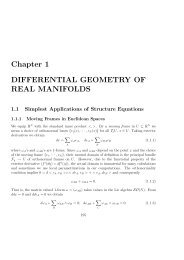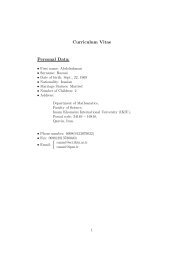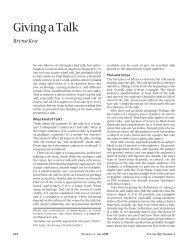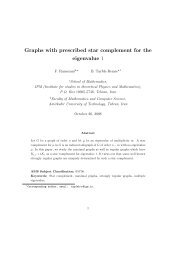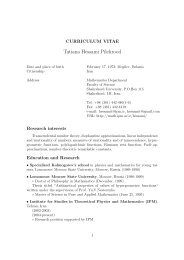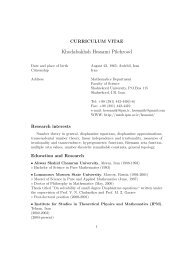1 Continuous Time Processes - IPM
1 Continuous Time Processes - IPM
1 Continuous Time Processes - IPM
Create successful ePaper yourself
Turn your PDF publications into a flip-book with our unique Google optimized e-Paper software.
where dvS(y) denotes the standard volume element on the sphere Sm−1 ρ (x).<br />
Therefore we have<br />
<br />
p(x) =<br />
S m−1<br />
p(y)<br />
ρ (x) vol(Sm−1 ρ (x)) dvS(y), (1.5.14)<br />
which is precisely the mean value property of harmonic functions. The<br />
boundary conditions are clearly satisfied by p and the required result follows.<br />
♣<br />
Remark 1.5.1 The condition that N is contained in the interior of M is<br />
intuitively clear in low dimensions and can be defined precisely in higher<br />
dimensions but it is not appropriate to dwell on this point in this context.<br />
This is not an essential assumption since the same conclusion remains valid<br />
even if D is an unbounded region by requiring the solution to Laplace’s<br />
equation to vanish at infinity. ♥<br />
Remark 1.5.2 We are in fact using the strong Markov property of Brownian<br />
motion. This application of this property is sufficiently intuitive that we did<br />
give any further justification. ♥<br />
Example 1.5.5 We specialize proposition 1.5.1 to dimensions 2 and 3 with<br />
N a sphere of radius ɛ > 0 and M a sphere of radius R, both centered at<br />
the origin. In both cases we can obtain the desired solutions by writing the<br />
Laplacian ∆m in polar coordinates:<br />
and<br />
∆2 = 1<br />
r<br />
∆3 = 1<br />
r2 <br />
∂ ∂ 1<br />
r2 +<br />
∂r ∂r sin θ<br />
∂ ∂ 1<br />
(r ) +<br />
∂r ∂r r2 ∂2 ,<br />
∂θ2 ∂ ∂ 1<br />
(sin θ ) +<br />
∂θ ∂θ sin2 θ<br />
∂2 ∂φ2 <br />
.<br />
Looking for spherically symmetric solutions pm (i.e., depending only on the<br />
variable r) the partial differential equations reduce to ordinary differential<br />
equations which we easily solve to obtain the solutions<br />
p2(x) =<br />
log r − log R<br />
, for x = (r, θ), (1.5.15)<br />
log ɛ − log R<br />
43



